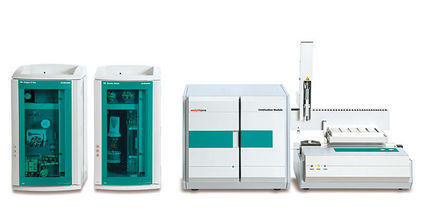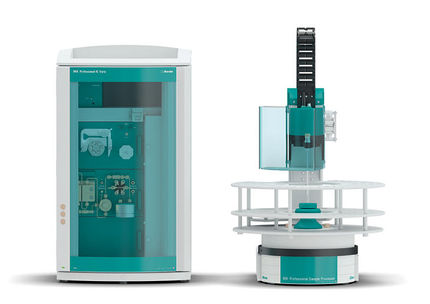The endocrine system is an integrated system of small organs that involve the release of extracellular signaling molecules known as hormones. The endocrine system is instrumental in regulating metabolism, growth and development and puberty, tissue function, and plays a part also in mood.[1]
The field of medicine that deals with disorders of endocrine glands is endocrinology, a branch of the wider field of internal medicine.
Function
The Endocrine system is an information signal system much like the nervous system. However, the nervous system uses nerves to conduct information, whereas the endocrine system mainly uses blood vessels as information channels. Glands located in many regions of the body release into the bloodstream specific chemical messengers called hormones. Hormones regulate the many and varied functions of an organism, e.g., mood, growth and development, tissue function, and metabolism, as well as sending messages and acting on them.
Types of signaling
The typical mode of cell signaling in the endocrine system is endocrine signaling. However, there are also other modes, i.e., paracrine, autocrine, and neuroendocrine signaling [2]. Purely neurocrine signaling between neurons, on the other hand, belongs completely to the nervous system.
Endocrine
A number of glands that signal each other in sequence is usually referred to as an axis, for example the Hypothalamic-pituitary-adrenal axis.
Typical endocrine glands are the pituitary, thyroid, and adrenal glands. Features of endocrine glands are, in general, their ductless nature, their vascularity, and usually the presence of intracellular vacuoles or granules storing their hormones. In contrast exocrine glands such as salivary glands, sweat glands, and glands within the gastrointestinal tract tend to be much less vascular and have ducts or a hollow lumen.
Autocrine
Main article: Autocrine signalling
Other signaling can target the same cell.
Paracrine
Main article: Paracrine signalling
Paracrine signaling is where the target cell is nearby.
Juxtacrine
Main article: Juxtacrine signalling
Juxtacrine signals are transmitted along cell membranes via protein or lipid components integral to the membrane and are capable of affecting either the emitting cell or cells immediately adjacent.
Role in disease
Main article: Endocrine diseases
Diseases of the endocrine system are common,[3] including diseases such as diabetes mellitus, thyroid disease, and obesity.
Endocrine disease is characterised by dysregulated hormone release (a productive Pituitary adenoma), inappropriate response to signalling (Hypothyroidism), lack or destruction of a gland (Diabetes mellitus type 1, diminished erythropoiesis in Chronic renal failure), or structural enlargement in a critical site such as the neck (Toxic multinodular goitre). Hypofunction of endocrine glands can occur as result of loss of reserve, hyposecretion, agenesis, atrophy, or active destruction. Hyperfunction can occur as result of hypersecretion, loss of suppression, hyperplastic, or neoplastic change, or hyperstimulation.
Endocrinopathies are classified as primary, secondary, or tertiary. Primary endocrine disease inhibits the action of downstream glands. Tertiary endocrine disease is associated with dysfunction of the hypothalamus and its releasing hormones.
Cancer can occur in endocrine glands, such as the thyroid, and hormones have been implicated in signalling distant tissues to proliferate, for example the Estrogen receptor has been shown to be involved in certain breast cancers. Endocrine, Paracrine, and autocrine signalling have all been implicated in proliferation, one of the required steps of oncogenesis.[4]
Table of endocrine glands and secreted hormones
This is a table of the glands of the endocrine system, and their secreted hormones
Hypothalamus
Pineal body
| Secreted hormone | From cells | Effect
|
| Melatonin (Primarily)
| Pinealocytes | antioxidant and causes drowsiness
|
Pituitary gland (hypophysis)
Anterior pituitary lobe (adenohypophysis)
Posterior pituitary lobe (neurohypophysis)
| Secreted hormone | Abbreviation | From cells | Effect
|
| Oxytocin
| | Magnocellular neurosecretory cells | Contraction of cervix and vagina
Involved in orgasm, trust between people.[5] and circadian homeostasis (body temperature, activity level, wakefulness) [6].
release breast milk
|
| Vasopressin or antidiuretic hormone
| AVP or ADH | Magnocellular neurosecretory cells | retention of water in kidneys
moderate vasoconstriction
|
Intermediate pituitary lobe (pars intermedia)
Thyroid
Parathyroid
| Secreted hormone | Abbreviation | From cells | Effect
|
| Parathyroid hormone
| PTH | Parathyroid chief cell | increase blood Ca2+: *indirectly stimulate osteoclasts
- Ca2+ reabsorption in kidney
- activate vitamin D
(Slightly) decrease blood phosphate:
- (decreased reuptake in kidney but increased uptake from bones
- activate vitamin D)
|
Heart
| Secreted hormone | Abbreviation | From cells | Effect
|
| Atrial-natriuretic peptide
| ANP | Cardiac myocytes | Reduce blood pressure by:
reducing systemic vascular resistance,
reducing blood water, sodium and fats
|
| Brain natriuretic peptide
| BNP | Cardiac myocytes | (To a minor degree than ANP) reduce blood pressure by:
reducing systemic vascular resistance,
reducing blood water, sodium and fats
|
Striated muscle
Skin
| Secreted hormone | From cells | Effect
|
| Calcidiol (25-hydroxyvitamin D3)
| | Inactive form of Vitamin D3
|
Adipose tissue
| Secreted hormone | From cells | Effect
|
| Leptin (Primarily)
| Adipocytes | decrease of appetite and increase of metabolism.
|
| Estrogens[8] (mainly Estrone)
| Adipocytes |
|
Stomach
Duodenum
Liver
Kidney
Adrenal glands
Adrenal cortex
Adrenal medulla
| Secreted hormone | From cells | Effect
|
| Adrenaline (epinephrine) (Primarily)
| Chromaffin cells | Fight-or-flight response:
- Boost the supply of oxygen and glucose to the brain and muscles (by increasing heart rate and stroke volume, vasodilation, increasing catalysis of glycogen in liver, breakdown of lipids in fat cells)
- Dilate the pupils
- Suppress non-emergency bodily processes (e.g., digestion)
- Suppress immune system
|
| Noradrenaline (norepinephrine)
| Chromaffin cells | Fight-or-flight response:
- Boost the supply of oxygen and glucose to the brain and muscles (by increasing heart rate and stroke volume, vasoconstriction and increased blood pressure, breakdown of lipids in fat cells)
- Increase skeletal muscle readiness.
|
| Dopamine
| Chromaffin cells | Increase heart rate and blood pressure
|
| Enkephalin
| Chromaffin cells | Regulate pain
|
Testes
| Secreted hormone | From cells | Effect
|
| Androgens (chiefly testosterone)
| Leydig cells | Anabolic: growth of muscle mass and strength, increased bone density, growth and strength,
Virilizing: maturation of sex organs, formation of scrotum, deepening of voice, growth of beard and axillary hair.
|
| Estradiol
| Sertoli cells | Prevent apoptosis of germ cells[12]
|
| Inhibin
| Sertoli cells | Inhibit production of FSH
|
Ovary
These originate either from the ovarian follicle or the corpus luteum.
| Secreted hormone | From cells | Effect
|
| Progesterone
| Granulosa cells, theca cells | Support pregnancy[13]:
- Convert endometrium to secretory stage
- Make cervical mucus permeable to sperm.
- Inhibit immune response, e.g., towards the human embryo
- Decrease uterine smooth muscle contractility[13]
- Inhibit lactation
- Inhibit onset of labor.
Other:
- Raise epidermal growth factor-1 levels
- Increase core temperature during ovulation[14]
- Reduce spasm and relax smooth muscle (widen bronchi and regulate mucus)
Anti-inflammatory
- Reduce gall-bladder activity[15]
- Normalize blood clotting and vascular tone, zinc and copper levels, cell oxygen levels, and use of fat stores for energy
- Assist in thyroid function and bone growth by osteoblasts
- Increase resilience in bone, teeth, gums, joint, tendon, ligament, and skin
- Promote healing by regulating collagen
- Provide nerve function and healing by regulating myelin
- Prevent endometrial cancer by regulating effects of estrogen
|
| Androstenedione
| Theca cells | Substrate for estrogen
|
| Estrogens (mainly estradiol)
| Granulosa cells | Structural:
- Promote formation of female secondary sex characteristics
- Accelerate height growth
- Accelerate metabolism (burn fat)
- Reduce muscle mass
- Stimulate endometrial growth
- Increase uterine growth
- Maintain blood vessels and skin
- Reduce bone resorption, increase bone formation
Protein synthesis:
- Increase hepatic production of binding proteins
Coagulation:
Fluid balance:
Gastrointestinal tract:
- Reduce bowel motility
- Increase cholesterol in bile
Melanin:
Cancer:
- Support hormone-sensitive breast cancers [16] (Suppression of production in the body of estrogen is a treatment for these cancers.)
Lung function:
- Promote lung function by supporting alveoli[17].
|
| Inhibin
| Granulosa cells | Inhibit production of FSH from anterior pituitary
|
Placenta (when pregnant)
| Secreted hormone | Abbreviation | From cells | Effect
|
| Progesterone (Primarily)
| | | Support pregnancy[13]:
- Inhibit immune response, towards the fetus.
- Decrease uterine smooth muscle contractility[13]
- Inhibit lactation
- Inhibit onset of labor.
- Support fetal production of adrenal mineralo- and glucosteroids.
Other effects on mother similar to ovarian follicle-progesterone
|
| Estrogens (mainly Estriol) (Also Primarily)
| | | Effects on mother similar to ovarian follicle estrogen
|
| Human chorionic gonadotropin
| HCG | Syncytiotrophoblast | promote maintenance of corpus luteum during beginning of pregnancy
Inhibit immune response, towards the human embryo.
|
| Human placental lactogen
| HPL | Syncytiotrophoblast | increase production of insulin and IGF-1
increase insulin resistance and carbohydrate intolerance
|
| Inhibin
| | Fetal Trophoblasts | suppress FSH
|
Uterus (when pregnant)
| Secreted hormone | Abbreviation | From cells | Effect
|
| Prolactin
| PRL | Decidual cells | milk production in mammary glands
|
| Relaxin
| | Decidual cells | Unclear in humans
|
See also
- Releasing hormones
- Neuroendocrinology
- Nervous system
- Endocrine disruptor
- Major systems of the human body
Links
- Journals Designed for Clinical Endocrinologists
- Islet cell antibody
- Binding of antibody to pancreas
- Kidshealth.org
References
- ^ Collier, Judith. et.al (2006). Oxford Handbook of Clinical Specialties 7th edn.. Oxford, 350 -351. ISBN 0-19-853085-4.
- ^ University of Virginia - HISTOLOGY OF THE ENDOCRINE GLANDS
- ^ Kasper et al. (2005). Harrison's Principles of Internal Medicine. McGraw Hill, 2074. ISBN 0-07-139140-1.
- ^ Bhowmick NA, Chytil A, Neilson EG, Moses HL (2004). "TGF-beta signaling in fibroblasts modulates the oncogenic potential of adjacent epithelia.". Science Feb 6 303(5659): 848-51.
- ^ Kosfeld M et al. (2005) Oxytocin increases trust in humans. Nature 435:673-676. PDF PMID 15931222
- ^ Scientific American Mind, "Rhythm and Blues"; June/July 2007; Scientific American Mind; by Ulrich Kraft
- ^ a b c Kaushansky K. Lineage-specific hematopoietic growth factors. N Engl J Med 2006;354:2034-45. PMID 16687716.
- ^ The adipose tissue as a source of vasoactive factors. Frühbeck G. (Curr Med Chem Cardiovasc Hematol Agents. 2004 Jul;2(3):197-208.)
- ^ http://www.vivo.colostate.edu/hbooks/pathphys/endocrine/otherendo/somatostatin.html Colorado State University - Biomedical Hypertextbooks - Somatostatin
- ^ Diabetes-related changes in contractile responses of stomach fundus to endothelin-1 in streptozotocin-induced diabetic rats Journal of Smooth Muscle Research Vol. 41 (2005) , No. 1 35-47. Kazuki Endo1), Takayuki Matsumoto1), Tsuneo Kobayashi1), Yutaka Kasuya1) and Katsuo Kamata1)
- ^ a b Physiology at MCG 5/5ch4/s5ch4_17
- ^ Pentikäinen V, Erkkilä K, Suomalainen L, Parvinen M, Dunkel L. Estradiol Acts as a Germ Cell Survival Factor in the Human Testis in vitro.
The Journal of Clinical Endocrinology & Metabolism 2006;85:2057-67 PMID 10843196
- ^ a b c d http://www.vivo.colostate.edu/hbooks/pathphys/reprod/placenta/endocrine.html
- ^ Physiology at MCG 5/5ch9/s5ch9_13
- ^ Hould F, Fried G, Fazekas A, Tremblay S, Mersereau W (1988). "Progesterone receptors regulate gallbladder motility". J Surg Res 45 (6): 505-12. PMID 3184927.
- ^ http://www.breastcancer.org/tre_sys_hrt_idx.html
- ^ Massaro D, Massaro GD (2004). "Estrogen regulates pulmonary alveolar formation, loss, and regeneration in mice". American Journal of Physiology. Lung Cellular and Molecular Physiology 287 (6): L1154-9. PMID 15298854 url=http://ajplung.physiology.org/cgi/content/full/287/6/L1154.
| Human organ systems |
|---|
| Cardiovascular system • Digestive system • Endocrine system • Immune system • Integumentary system • Lymphatic system • Muscular system • Nervous system • Reproductive system • Respiratory system • Skeletal system • Urinary system |
| Human anatomy, endocrine system: endocrine glands |
|---|
| Hypothalamic/pituitary axes | Adrenal axis: Adrenal gland
Thyroid axis: Thyroid gland (Parafollicular cell, Thyroid epithelial cell) - Parathyroid gland (Oxyphil cell, Chief cell)
Gonadal axis: Testes - Ovaries - Corpus luteum |
|---|
| Other | Pineal gland • Islets of pancreas |
|---|
| Endocrine system: hormones/endocrine glands (Peptide hormones, Steroid hormones) |
|---|
| Hypothalamic-pituitary | Hypothalamus: TRH, CRH , GnRH, GHRH, somatostatin, dopamine - Posterior pituitary: vasopressin, oxytocin - Anterior pituitary: α (FSH, LH, TSH), GH, prolactin, POMC (ACTH, MSH, endorphins, lipotropin) |
|---|
| Adrenal axis | Adrenal medulla: epinephrine, norepinephrine - Adrenal cortex: aldosterone, cortisol, DHEA |
|---|
| Thyroid axis | Thyroid: thyroid hormone (T3 and T4) - calcitonin - Parathyroid: PTH |
|---|
| Gonadal axis | Testis: testosterone, AMH, inhibin - Ovary: estradiol, progesterone, inhibin/activin, relaxin (pregnancy) |
|---|
| Other end. glands | Pancreas: glucagon, insulin, somatostatin - Pineal gland: melatonin |
|---|
| Non-end. glands | Placenta: hCG, HPL, estrogen, progesterone - Kidney: renin, EPO, calcitriol, prostaglandin - Heart atrium: ANP - Stomach: gastrin, ghrelin - Duodenum: CCK, GIP, secretin, motilin, VIP - Ileum: enteroglucagon - Adipose tissue: leptin, adiponectin, resistin - Thymus: Thymosin - Thymopoietin - Skeleton: Osteocalcin - Liver/other: Insulin-like growth factor (IGF-1, IGF-2) |
|---|
| Target-derived | NGF, BDNF, NT-3 |
|---|
| Endocrine pathology: endocrine diseases (E00-35, 240-259) |
|---|
| Thyroid | Hypothyroidism (Iodine deficiency, Cretinism, Congenital hypothyroidism, Goitre, Myxedema) - Hyperthyroidism (Graves disease, Toxic multinodular goitre, Teratoma with thyroid tissue or Struma ovarii) - Thyroiditis (De Quervain's thyroiditis, Hashimoto's thyroiditis, Riedel's thyroiditis) - Euthyroid sick syndrome |
|---|
| Pancreas | Diabetes mellitus (type 1, type 2, coma, angiopathy, ketoacidosis, nephropathy, neuropathy, retinopathy) - Hypoglycemia - Hyperinsulinism - Zollinger-Ellison syndrome |
|---|
| Parathyroid | Hypoparathyroidism (Pseudohypoparathyroidism) - Hyperparathyroidism (Primary, Secondary, Tertiary) |
|---|
| Pituitary | Hyperpituitarism (Acromegaly, Hyperprolactinaemia, SIADH) - Hypopituitarism (Simmonds' disease/Sheehan's syndrome, Kallmann syndrome, Growth hormone deficiency, Diabetes insipidus) - Adiposogenital dystrophy - Empty sella syndrome |
|---|
| Adrenal | Cushing's syndrome (Nelson's syndrome, Pseudo-Cushing's syndrome) - CAH (due to 21-hydroxylase deficiency) - Hyperaldosteronism (Conn syndrome, Bartter syndrome) - Adrenal insufficiency (Addison's disease) - Hypoaldosteronism |
|---|
| Gonads | ovarian dysfunction (Polycystic ovary syndrome, Premature ovarian failure) - testicular dysfunction (5-alpha-reductase deficiency) - general (Hypogonadism, Delayed puberty, Precocious puberty) |
|---|
| Other | Autoimmune polyendocrine syndrome - Carcinoid syndrome - Short stature (Laron syndrome, Psychogenic dwarfism) - Gigantism - Androgen insensitivity syndrome - Progeria - Multiple endocrine neoplasia (1, 2) |
|---|
| Endocrine system intervention (ICD-9-CM V3 06-07) |
|---|
| Operations, surgeries | Thyroidectomy - Parathyroidectomy - Adrenalectomy - Hypophysectomy - Thymectomy |
|---|
| Hormone therapy | in oncology - sex reassignment (female-to-male, male-to-female) |
|---|
| Other medication | Replacement therapy |
|---|
|







